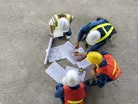Top 10 revolutionary construction innovations

While rudimentary examples of construction can be traced back 1.8 million years, an exact timeframe for the first evidence of construction is still up for debate. Some believe that the Olduvai Gorge in Tanzania resembles the foundations of stick or grass huts built by hunter-gatherers, while others believe that the first evidence of man-made shelter is in Terra Amata, France, dating back to 400,000 B.C.
However, one thing expects can agree on is the earliest evidence of large-scale buildings which can be found in Mesopotamia dating back to 4000 B.C. Mesopotamia is home to the first known roads, as well as palaces, temples, ziggurats, and dwellings.
Modern construction that we see today began to take shape in the 16th century, as more people settled in cities, construction required engineers, architects, coordination of materials, and rules to guide them. By the 17th and 18th centuries, construction began to experiment more with new materials and technologies following the industrial revolution.
Today, the construction industry is worth US$6.4tn (2020) and is expected to reach US$13.9tn by 2037. In this Top 10, Construction Digital takes a look at 10 revolutionary innovations of modern construction.
Building information modelling (BIM)
Building information modeling (BIM) can be traced back to the 70s. BIM is the holistic process of creating and managing information for a built asset. Defined as “the foundation of digital transformation in the architecture, engineering, and construction (AEC) industry”, BIM is based on an intelligent model and enabled by cloud platforms to integrate structured, multi-disciplinary data to produce a digital representation of an asset.
3D printing
Initially developed for prototyping purposes, the use of 3D printing has grown exponentially across industries. Specifically in the construction industry, 3D printing is being used for building walls and processing cement. Benefits of this technology in construction include speed; waste reduction; design freedom; reduced human error; recycling; and cost-effective.
Digital twins
Integrating real-time data from a built asset with its digital representation to create insights across a project’s lifecycle, digital twins are solving major challenges in both design and operations. The technology gives multi-dimensional views of how an asset is designed and how it is performing. Digital twins provide the scenario to test ‘what-ifs’.
Computer-aided design (CAD)
Computer-aided design (CAD) is computer-based software to create 2D drawings and 3D models to optimise and streamline the design workflow. The software provides increased productivity, improved quality and level of detail, and improved documentation communication.
CAD software uses electronic files to distribute and be used in the construction process. Other benefits of CAD software include lower production costs for designs; quicker project completion; changes that can be made independently of other design details; clearer designs; and easier collaboration.
Cloud computing
Cloud computing is the on-demand delivery of IT resources over the Internet. Instead of buying, owning, and maintaining physical data centers, cloud computing offers computing power, storage, and databases as needed from a cloud provider.
Benefits of cloud computing for the construction industry include Increased efficiency and communication; real-time updates; safer workspaces; reduced waste and environmental impact; improved quality; easier collaboration; and time savings.
Green building materials database
With the construction industry reportedly contributing to 23% of air pollution; 50% of climatic change; 40% of drinking water pollution; and 50% of landfill wastes, sustainable solutions are at the top of the agenda for the industry.
One such way includes the sustainable sourcing and production of building materials for construction projects. Effective Building - an Israeli startup company has developed a green building materials database to assist construction companies with their green building projects. The company collects technical and functional data of certified green products to allow users to filter for materials by technical properties.
Personal protective equipment (PPE)
While less technologically advanced than some of the other entries on this list, personal protective equipment (PPE) has been revolutionary when it comes to health and safety in the industry.
In 1992, the UK set regulations placing a duty on employees to provide appropriate PPE for workers, a performance review in 2008 found that between 1974 (the start of the Health and Safety at Work, etc. Act) and 2007 that the number of fatal injuries fell by 73% and non-fatal injuries fell by 70%.
Similarly in America, the Occupational Safety and Health Act of 1970, with other countries around the world followed suit including PPE legislation.
Self-healing concrete
Responsible for 7% of the annual global carbon emissions, concrete cracking is a significant challenge in construction and is usually caused by exposure to water and chemicals. Currently, researchers at Bath University are developing self-healing concrete.
Using a mix that contains bacteria within microcapsules, the innovation aids those in construction by geminating when water enters a crack to produce limestone plugging the crack, and stopping water and oxygen from corroding the steel reinforcements.
Modular construction
A popular construction method, modular construction involves the production of standard components of a structure in an off-site factory which are then assembled on-site. Often terms such as ‘off-site construction’; ‘prefabrication’; and ‘modular construction’ are used interchangeably.
Benefits of modular construction include reduced environmental disruption; saving time; reduced reliance on good weather; reduced storage requirements; lower labour costs; and reduced waste.
This process moves the industry closer to a just-in-time (JIT) approach to construction.
Asset mapping
Focusing on operational equipment - heating, air conditioning, lighting and security systems - asset mapping collects data from serial numbers, firmware, and engineering notes combining the data into one place. This allows engineers to see in real-time where the equipment is needed. Once connected to real-time systems, the equipment can be monitored remotely to help customers to monitor asset performance, be proactive in building maintenance, and reduce building procurement and insurance costs.
- How Samsung & FläktGroup are Shaping the Future of HVACMaintenance & Operations
- Could Self-Healing Concrete Reshape Global Construction?Construction Projects
- ABB's Role in Vulcan Energy's Bold Construction ProjectSustainability & Green Building
- Siemens: Helping Operators Build Future-Ready Data CentresMaintenance & Operations



